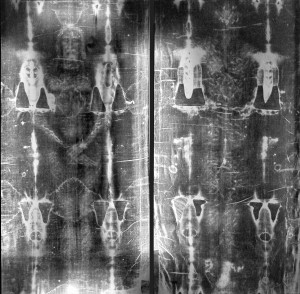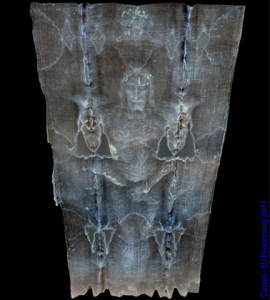The Shroud of Turin
“Digits Dei est hic” – “The Finger of God is Here”
Pope John XXIII
[su_row]
[su_column size=”1/4″]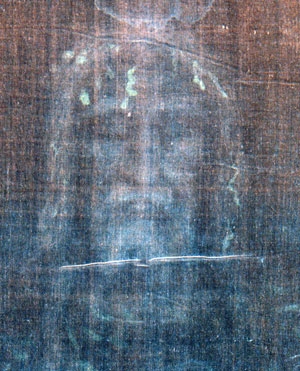
Promises of Christ —
- I will grant them contrition so perfect that their very sins shall be changed in My sight into jewels of precious gold.
- None of these persons shall ever be separated from Me.
- In offering My Face to My Father, they will appease His anger and they will purchase as with celestial coin, pardon for poor sinners.
- I will open My mouth to plead with My Father to grant all the petitions that they will present to Me.
- I will illuminate them with My light, I will consume them with My love and I will render them fruitful of good works.
- They will, as the pious Veronica, wipe My adorable Face outraged by sin, and I will imprint My divine Features in their souls.
- At their death, I will renew in them the image of God effaced by sin.
- By resemblance to My Face, they will shine more than many others in eternal life and the brilliancy of My Face will fill them with joy.
[/su_column]
[su_column size=”1/2″]THE POSITION OF THE CHURCH – WORTHY OF BELIEF
Many of the faithful sincerely believe that the Shroud of Turin is the actual burial cloth of our Lord, Jesus Christ. Without declaring its authenticity, Pope John Paul II has clearly attested to the value of the Shroud. For instance, in 1980, the Holy Father stated, “The Holy Shroud, the most splendid relic of the passion and the resurrection.” Almost ten years later, in April 1989, he was asked by reporters during an in-flight press conference on the way to Madagascar about the Shroud, and he responded, “It certainly is a relic.” Again, almost ten years later, when asked if the Shroud was genuine, the Pope said, I think it is.” (as reported in Columbia, 1998). The Holy Father has visited the Shroud both in 1978 and most recently this past June 1998.His predecessors have also viewed the Shroud favorably. Pope Pius XII stated, A precious treasure, the Holy Shroud, which displays, both to move and comfort us, the image of the lifeless body and tortured face of Christ.” And Pope John XXIII declared, “Digits Dei est hic” (“The finger of God is here.”)
However, to believe that the Shroud is the actual burial cloth of the Lord is not a matter of faith. No Catholic is bound to believe it is. As Cardinal Saldarini of Turin stated, “It’s not Christ, but something that brings us back to him. Salvation is not in the Shroud, even if it truly wrapped the martyred body of Jesus, even if it was mysteriously given by God to His Church. Salvation is that which is given to us by Christ.” (Columbia, June 1998).Nevertheless, the Church has been the official guardian of the Shroud for the House of Savoy, the former ruling family of Italy. In 1983, the Savoy family willed the Shroud to the Holy Father with the Archbishop of Turin serving as the Pontifical Guardian for the Conservation and Veneration of the Holy Shroud
Part of the uncertainty as to the authenticity of the Shroud arises from its historical record. Of course, the Shroud is believed to be the burial cloth used by Joseph of Arimathaea to wrap the body of Jesus for burial. Documentation shows that the Shroud indeed was displayed in the cities of Jerusalem, Edessa (500) and Constantinople (1092). King Louis VII of France venerated the shroud in Constantinople in 1147. In August 1203, Robert de Clari, a French crusader, reported seeing the Shroud in Constantinople. Although some gaps appear in its historical whereabouts, the Shroud has maintained a consistent presence.After Robert de Clari’s testimony, the next historical citing places the Shroud in France, having passed to the possession of the De Charny family of Lirey. Probably the Shroud was obtained during the Crusades and brought to Europe. The first public exhibition of the Shroud, held full length, occurred in 1357, sponsored by the Canons of the Cathedral of Lirey.In March 1453, Margaret de Charny gave the Shroud to the House of Savoy, and it was kept at the Chapel of Chambery Castle (June 11, 1502). The Shroud survived fire on Dec. 4, 1532, but was burned at its folded corners when its silver reliquary began to melt. (To date, one can see the patches applied to the Shroud because of the burn marks.) Finally, the Shroud was moved to the Cathedral of Turin on Sept. 14, 1578, where it has since remained in the Royal Chapel.[/su_column]
[su_column size=”1/4″]
[/su_column]
[/su_row]
MORE INFORMATION ON THE SHROUD
During the medieval period, other supposed shrouds were reported and displayed, such as in Chambery, France; Lierre, Belgium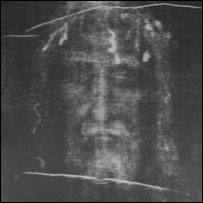 ; and Acireale, Sicily. However, each of these was clearly a copy, produced by the artist’s hand.
; and Acireale, Sicily. However, each of these was clearly a copy, produced by the artist’s hand.
The real scientific investigation into the Shroud began in May 1898, when Secundo Pia photographed the Shroud. When he was developing the film plate, he discovered that the negative image is actually the positive, and vice versa: basically, when one looks at the Shroud with the naked eye, he sees a light yellow-brownish figure of a man; but when one looks at a photographic black and white negative, he can see the image in greater detail.
Pia’s discovery sparked great interest in the Shroud. In more recent times, extensive research has been performed on the Shroud, beginning with the STURP (Shroud of Turin Research Project) team in 1978.
Here is a brief overview of the major scientific findings: the Shroud is a long, linen sheet about 4.36 meters long by 1.1 meters wide. Jesus would have been laid down on top of the Shroud, and then it would have been folded over Him. Interestingly, the frontal image is a little short, and the cloth covers only part of the right foot.
The Shroud is made of linen. Linen making has been known for the last nine thousand years with Galilee being an important manufacturing center of the cloth. This cloth is also very durable: Egyptian linen wrappings on mummies at least 4,000 years old survive to this day, which means the Shroud could have been produced at the time of Christ.
The weave is a herringbone pattern with the twist of the yarn being a “z” twist (meaning the spindle was rotated clockwise). The cloth also has a high thread count, which produced a fine cloth. Although such cloth was not common, it was not unusual at the time of the Lord especially in the Middle East area. Moreover, cotton fibers particular to the kind of cotton found in Palestine are also present in the linen cloth.
Pollen evidence also places the origins of the Shroud in the Middle East. Pollen, because of its outer shell, the exine, can survive literally tens of thousands of years. Dr. Max Frei of the University of Zurich and founder of the Zurich Criminal Police’s Scientific Service found pollen, spores, and molds common to the habitats of the places where the Shroud had been reported. He also found pollen from halophytes, plants typical of the desert regions around the Jordan Valley and adapted to live in the soils with the high salt content found almost exclusively around the Dead Sea area.
The Shroud depicts the image of a man, slightly under six feet tall, who suffered the brutal death of crucifixion. The wound marks evidenced by blood stains correspond with the sufferings our Lord endured as accounted for in the Gospel. Nail wounds appear at the feet (with the sole of the right foot having a full and very bloody imprint since it was placed beneath the top of the left foot) and wrist (one hand covers the wrist of the other hand). Note that unlike most artist’s depictions, the victim of crucifixion was nailed in the wrist between the radius and ulna so that he could hang securely on the cross; nailing through the palm of the hand would not have provided such support.
Interestingly, the nail at the wrist would have penetrated a nerve and caused the thumb to snap into the palm. The thumbs of the man in the Shroud are hidden due to this nailing.
The Shroud does show a wound to the side, as where the soldier’s lance would have pierced the heart of our Lord. The spear passed through the fifth and sixth ribs, and pierced the pericardium and the right auricle, causing the flow of blood and pericardial fluid.
Blood stains around the forehead and nape of the neck could be attributed to the crown of thorns.
Blood stains also appear across the back, alternating right and left shoulders, and on the buttocks due to scourging. The scourge wounds fan-out, which makes sense since the flagellum used by the Romans had two or three leather throngs with small lead balls or hooks at the end to gouge the flesh of the victim. Clearly, the victim was whipped very methodically, and over 120 wound sites are present.
The blood is definitely human blood. The STURP team determined that the stains were human blood of the AB group. This finding has been corroborated by others: Professor Pierluigi Baima Bollone, Professor of Medicine at the University of Turin, reported in 1978 that the blood stains were indeed human blood with traces of aloes and myrrh and belonging to the group AB. French geneticist Professor Jerome Lejeune also concluded that the blood sample he obtained was human hemoglobin.
Another intriguing point is that the blood marks on the Shroud are clear and red, not dark brown as typical of dried blood. Also the blood stains are complete without signs of flaking off. Dr. Gilbert Lavoie suggested that what appears on the Shroud is more an exudate from clotted wounds rather than whole blood. Likewise, Dr. Alan Adler explained that the torture, scourging, and crucifixion suffered by the man produced a hemolysis (break-up of red blood corpuscles), which would produce the lasting red color of the exudate.
No pigments, paints, dyes, or stains have been found in the fibrils. X-ray flourescence and microchemistry on the fibrils eliminate the possibility of paint being used as a method of creating the image, and ultraviolet and infrared evaluation have confirmed these studies. If paint had been used, it would have penetrated through the top fibers onto the lower fibers in the herringbone weave; however, the image is only on the top fibers with the lower fibers being untouched. Also, the image was resistant to bleaching and other standard chemical agents that would have reacted with paint or some other medium.
Enhanced photography has also produced exciting evidence. The studies have included photographic enlargements and computer analysis of shapes, colors, and shadows. Also, a microdensitometer was used which measures very faint changes in lightness and darkness. In 1979, Father Francis L. Filas, S.J., of the Loyola University of Chicago, using the STURP research, observed on the right eyelid of the man four letters UCAI which formed a crown around the crook of an augur’s staff. This image corresponds to the symbol on a small coin struck in A.D. 29 during the procuratorship of Pontius Pilate (AD 26-36). The ancient Jews used coins to hold down the eyelids. Also, Father Filas noted that later Byzantine coinage was engraved with an image of Christ Pantocrator which bore a striking resemblance to the facial image of the Shroud, which would attest to the Shroud’s presence in Constantinople.
In 1978, Piero Ugolotti reported that he had detected barely visible traces of letters and words in Greek, Latin, and Hebrew near the face on the Shroud, which were corroborated by philologist Aldo Marastoni of the Catholic University of Milan. In 1995, scientists with the Paris Institut d’Optique also reported finding letters and words on the sides of the facial image on the Shroud. An example would be In Necem, an abbreviation of the Latin death phrase, In Necem Ibis (“You will go to death”), Nazarennus (“Nazarene”), and Pezo which means “to accomplish” in archaic Greek but in the sense of “celebrating a sacrifice.”
The image also has unique, three-dimensional information encoded in it. Using a VP-8 Image Analyzer (which NASA has used to produce pictures of planets from light signals picked-up electronically and transmitted to earth), Dr. John Jackson of the STURP team produced a three-dimensional picture from the Shroud. Note that a regular two-dimensional image, such as that of a painting or a photograph, will only produce a badly contorted image in the VP-8 screen. Only when actual depth or remoteness is shown by less light does the VP-8 produce a three-dimensional picture. This evidence again confirms that the Shroud is not like a painting.
The photographs of the Shroud also seem to be like X-rays with the images of bones visible. Dr. Michael Blunt, Challis Professor of Anatomy at the University of Sydney, noted that in the hands one can see metacarpal bones and three phalange bones of each finger. Professor Alan Whanger of Duke University noted that the skull is visible.
Dr. Gilbert Lavoie in his recent work, Unlocking the Secrets of the Shroud, presented another intriguing discovery. The negative image of the Shroud as compared with the negative images of photography reveals that the man in question had either white or light blond hair. He noted another peculiarity: the shadows of the face and the fall of the hair indicate that the man was upright and suspended when the image was made, while the blood marks indicate the man was in the supine position on top of the cloth with the rest folded over him. Dr. Lavoie concluded that this upright image was made after the blood had stained the cloth: “This finding is intellectually exciting to anyone who contemplates the possibility that this image reflects the moment of the resurrection” (p. 182).
The STURP team provided the following summary of its findings, worth noting after a review of all of this evidence: We can conclude for now that the Shroud image is that of a real human form of a scourged, crucified man. It is not the product of an artist. The blood stains are composed of hemoglobin and also give a positive test for serum albumin. The image is an ongoing mystery and until further chemical studies are made, perhaps by this group of scientists, or perhaps by some scientist in the future, the problem remains unsolved.” Although the STURP team did not declare the Shroud to be the actual burial cloth of Christ, the evidence presented at least supports a person’s private belief that it is
Given the scientific evidence, we can summarize that the Shroud evidences a crucified man, who was crowned with thorns and scourged, and who lived in the area of Palestine near Jerusalem at the time of Pontius Pilate. However, significant controversy remains about the Shroud.
The first point of controversy surrounds the burial rites of the Jews. Normally, the Jews followed a funerary practice of taharah, whereby the corpse was scrupulously washed from head to foot, and then dressed in tachrichim, a set of burial garments including a head covering, shirt, breeches, surplice and girdle. The person was then wrapped in a sovev, a long cloth which wrapped around the entire body.
At first glance, the naked, bloody man wrapped in the Shroud contradicts these regulations and therefore would make it unlikely that he was Jesus, a Jew. However, further research has shown that when a person suffered a violent death, such as crucifixion, there would be no taharah, since all bodily parts, even blood, had to be preserved for the future resurrection of the body. Also is such a case, the person would only be buried with the clothes they were wearing with no tachrichim; since the man of the Shroud was naked, which was normal for crucifixion, he was buried only in the sovev.
Second, what is to say that the Shroud is not some clever medieval artist’s forgery? (The medieval period is pinpointed because of the carbon dating, as discussed later.) As stated previously, no pigments, paints, dyes, or stains have been found in the fibrils; the image is only on the top fibrils with no penetration to the lower ones, as would have been caused by paint or some other medium; and the image was resistant to bleaching and other standard chemical agents that would have reacted with paint or some other medium.
Moreover, Isabel Piczek, noted painter and art historian, concluded that no painter at the time could have produced the Shroud, just from the aspect of skill and knowledge. First, no medieval artist knew the details of crucifixion since it had been outlawed since the year 400; for instance, only a few Baroque artists, painting much later, captured the detail of the nail wounds at the wrists, such as Van Dyck’s paintings of the crucifixion. Medieval artists also did not have a thorough knowledge of anatomy since the dissection of human bodies was virtually outlawed by the Church at that time. Also, for an artist to purposely paint the Shroud with the front side being short, not covering the right foot seems totally improbable. Interestingly too, that where the blood stains appear, there is no image underneath on the fibrils, suggesting that the image had been made last after the blood stains; obviously, an artist would have worked in reverse, painting the image and then applying the blood stains. Finally, no medieval artist had the skill to paint a negative image or the perfection of the image with such subtle coloration.
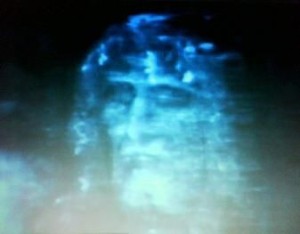 How then was the image made if it was not painted? (This subject was discussed by members of the STURP team, but they did not arrive at a conclusion.) The color of the Shroud image is “yellow or straw yellow” as classified by the STURP team. The image is a surface image, affecting the topmost fibers only without any apparent penetration to any depth (again disproving the “painting” theory). The image seems almost like a big scorch mark, like the scorch marks left from an iron. Also, the fibers on the image appear older and degraded when compared with the fibers outside the image, as though something were taken away from them rather than added, like paint. Yet, the fibers of the image are different from scorch fibers: ultraviolet fluorescence photography revealed that the body image does not fluoresce red when irradiated with ultraviolet light, whereas the scorched areas caused by the fire of 1532 do. Some of the scientists, therefore, posited that a type a thermo-nuclear reaction occurred which caused the image on the Shroud. Actually, when one thinks of Jesus rising body and soul from the dead in a radically transformed existence, such a scientific theory is enticing.
How then was the image made if it was not painted? (This subject was discussed by members of the STURP team, but they did not arrive at a conclusion.) The color of the Shroud image is “yellow or straw yellow” as classified by the STURP team. The image is a surface image, affecting the topmost fibers only without any apparent penetration to any depth (again disproving the “painting” theory). The image seems almost like a big scorch mark, like the scorch marks left from an iron. Also, the fibers on the image appear older and degraded when compared with the fibers outside the image, as though something were taken away from them rather than added, like paint. Yet, the fibers of the image are different from scorch fibers: ultraviolet fluorescence photography revealed that the body image does not fluoresce red when irradiated with ultraviolet light, whereas the scorched areas caused by the fire of 1532 do. Some of the scientists, therefore, posited that a type a thermo-nuclear reaction occurred which caused the image on the Shroud. Actually, when one thinks of Jesus rising body and soul from the dead in a radically transformed existence, such a scientific theory is enticing.
The most critical controversy surrounds the carbon dating testing done in 1988. On April 21, 1988, Anastasio Cardinal Ballestrero of Turin supervised Italian microanalyst Dr. Giovanni Riggi cutting a 2 inch by 3 inch strip from the linen Shroud away from the central image or scorched areas, but from a corner site. The sample was then divided into three samples and given to the carbon dating laboratories at Zurich, Oxford, and the University of Arizona at Tucson, with each performing three radio carbon measurements.
Simply, radio carbon dating measures the amount of an isotope called carbon 14, which is present in all organic substances, including flax plants from which linen is made. Carbon 14 decays over time in dead material at a fixed rate; therefore, the amount of residual carbon 14 can reveal the measurement of something’s age.
In October, the results were announced at a press conference. On a blackboard was written “A.D. 1260 – 1390,” the time span of years for when the Shroud was produced according to the carbon dating results. Dr. Henry Gove, a nuclear physicist, said the odds were “about one in a thousand trillion” against the Shroud having been woven in the time of Jesus, and called those who believe in the genuineness of the Shroud “flat-earthers.”
However, several scientists objected to the “infallible” pronouncements made by the laboratories. For instance, Dr. Rosalie David of the Manchester Museum has performed autopsies on Egyptians mummies, and has used carbon dating to corroborate the age of them; however, sometimes carbon dating indicates a date a thousand years younger than the actual date of the mummy known through other archeological evidence. Such a discrepancy would be caused by some source of contamination.
Contamination to the Shroud could alter the accuracy of the carbon dating. Exposure to years of candle soot in the cathedral and Turin pollution, the drenching with water during the fire, and the accumulation of minuscule fragments of deteriorating ceiling frescos would give the Shroud a coating which could in turn skew the carbon dating results. Moreover, a corner sample which over the years had been handled by many individuals would probably be contaminated. Such items enrich the carbon content and would make the Shroud appear substantially younger than its true age when carbon dated.
Dr. Leoncio Garza-Valdes of the University of Texas , working with microbiologist Dr. Stephen Mattingly of the University of Texas Health Science Center at San Antonio, provided another argument against the carbon dating results. They argued that the Shroud could have a bioplastic varnish or coating caused by bacteria and fungi. Dr. Garza-Valdes discovered such coatings in research with Mayan artifacts, which he knew belonged to a certain age, but when carbon dated were declared much younger and thereby fakes. This bioplastic coating is almost like plaque on teeth, and would have grown especially at the corner of the Shroud where it was handled so much.
Receiving a small sample of threads, Garza-Valdes determined the presence of a bioplastic coating on the Shroud, which has “coccal-shapped bacteria and filiamentous mold-like organisms,” sometimes increasing the diameter of the fibers as much as 60 percent. Such a bioplastic coating could skew the carbon dating 1300 years. Also such a coating cannot be removed by the conventional cleaning methods of most carbon dating labs. If Dr. Garza-Valdes is correct, the Shroud easily would be placed at the time of our Lord.
In 2013, Giulio Fanti performed new dating studies on fragments obtained from the shroud. He performed three different tests including spectroscopy (absorption of light of different colours). The date range from these tests date the shroud between 300 BC and 400 AD, an average of 50 AD. These studies have been publicly disregarded by Mgr. Cesare Nosiglia, archbishop of Turin and custodian of the shroud. Cardinal Nosiglia stated that “as it is not possible to be certain that the analysed material was taken from the fabric of the shroud no serious value can be recognized to the results of such experiments”.
In all, the preponderance of evidence appears to support the authenticity of the Shroud of Turin as the burial cloth of our Lord.

